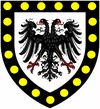Ancient and modern arms
Ancient and modern are terms used in heraldry to differentiate two different coats of arms used at different periods by a family or other bearer. Reasons for changing arms have been numerous, the most famous being the 1376 change in the French royal arms by Charles V of France to show three fleurs-de-lis instead of semee de lis, possibly to symbolize the Holy Trinity. The reasons for other changes were more prosaic, for example where a court of chivalry ordered a change or differencing where two families claimed the same arms, as in the famous case of Scrope v Grosvenor. The resulting two versions of arms are referred to as "France ancient" and "France modern", "Grosvenor ancient" and "Grosvenor modern".
List of examples
[edit]| Family | Ancient arms | Modern arms | Date of change | Notes |
|---|---|---|---|---|
| Capet (Royal arms of France) |  |
 |
1376 | See article Royal Arms of France |
| Portugal (Royal arms of Portugal) |  |
 |
1245 (first version of Portugal modern)/1485 (current version) | See article Coat of arms of Portugal |
| Denmark (Coat of arms of Denmark) |  |
 |
1819 | Originally the lions were heraldic leopards facing the viewer and the number of hearts (officially blazoned as waterlily pads) was not defined and could be much larger than today. The lions were defined as heraldic lions and the number of hearts specified to nine in 1819. |
| Grosvenor |  |
 |
1389 | See article Scrope v Grosvenor |
| Gorges |  |
 |
1347 | See article Warbelton v Gorges |
| Percy |  |
 |
1273-1314 | See article Henry de Percy, 1st Baron Percy |
| Talbot |  |
 |
See article Baron Talbot. Modern arms are of Rhys Mechyll (d.1244), Prince of the Welsh House of Dinefwr, grandson of Rhys ap Gruffydd), whose daughter Gwenllian was the wife of Gilbert Talbot (d.1274), grandfather of Gilbert Talbot, 1st Baron Talbot (d.1345/6) | |
| Cantilupe |  |
 |
1275-1282 | See article Thomas de Cantilupe |
| Killigrew |  |
 |
See article Arwenack | |
| Scudamore | ||||
| Crewe |  |
 |
bef. 1303 | Sir Thomas de Crewe, Lord of Crewe used a seal depicting fretwork with quatrefoils filling in the spaces.[3] His son Patrick would begin using a lion rampant, which became the modern arms of Crewe.[4] See the 17th century portrait of Sir Ranulphe Crewe by Peter Lely for a quartered depiction of both arms. |
See also
[edit]References
[edit]- ^ Dunkin, p.20; Tregellas, p.116, footnote. These mascle arms are also visible on the Wrey monument (see File:BlancheKilligrew TawstockChurch.JPG) now in Tawstock Church, Devon, (moved from St Ive Church, Cornwall) of Blanche Killigrew (d.1595) and her husband John Wrey (d.1597) of Trebeigh, St Ive, Cornwall. The monument was moved from St Ive Church to its present position against the east wall of the north transept of St Peter's Church, Tawstock, Devon, in 1924 by Sir Philip Bourchier Sherard Wrey, 12th Baronet (1858-1936), of Tawstock Court.(Pevsner, Nikolaus & Cherry, Bridget, The Buildings of England: Devon, London, 2004, p.790)
- ^ The bezantée bordure indicates a connection to the ancient Earls of Cornwall(See Martin Lister-Killigrew's History of the Killigrew Family [1]: "What their arms were before is uncertain, but from ye Heralds Office we know that in the time of Rchard Duke of Cornwall, brother of Henry III, and King of the Romans, he gave to Ralph de Killigrew the spread eagle, with the border of Cornwall, which undeniably denotes the family to be of consideration, so high back as those antient times"
- ^ Carter p. 117 The Early Crewe Pedigree
- ^ Hinchliffe p. 363 (Barthomley: In Letters from a Former Rector to his Eldest Son)
